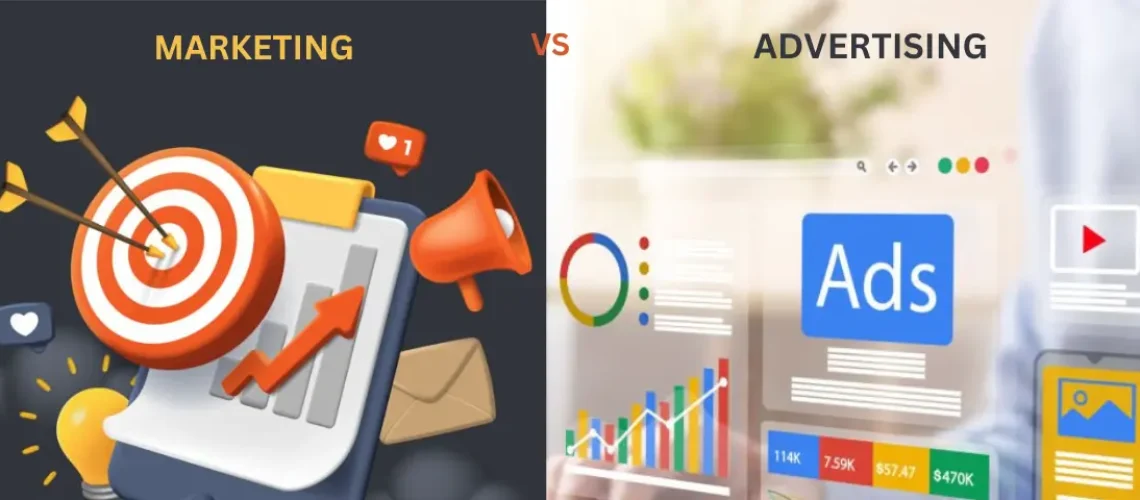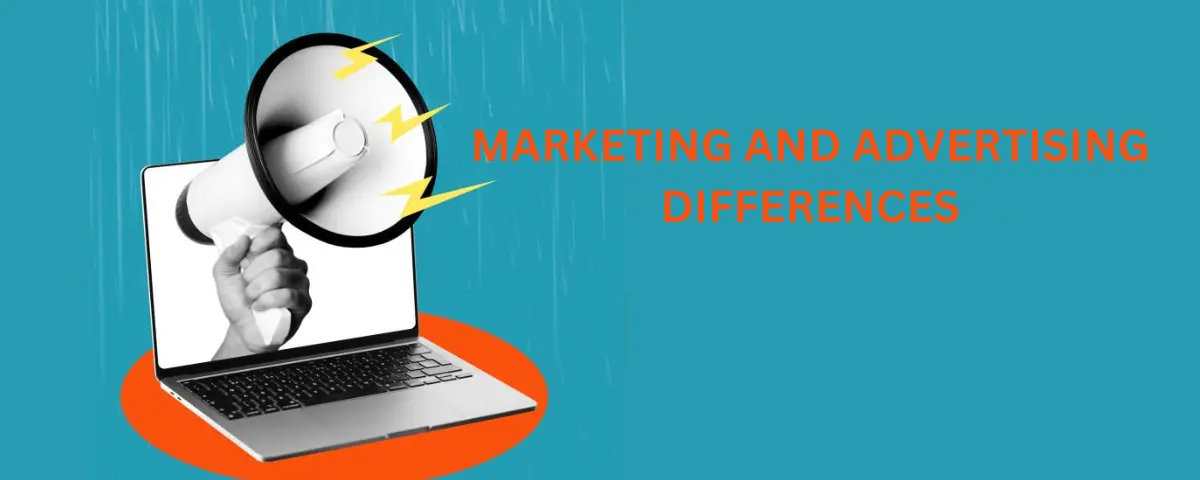Marketing and advertising are two terms that are often used interchangeably, but they are not the same thing. While both are essential for the success of a business, they serve different purposes and require different strategies.
While marketing has a broader scope, advertising is a tool used within the marketing process to achieve its goals. Advertising helps execute the marketing strategy by creating awareness, generating leads, and driving sales.
By understanding the differences between marketing and advertising, businesses can develop more effective strategies to reach their target audience and achieve their goals.
In this article, we will explore the key differences between marketing and advertising and how they work together to drive business growth.
What is Marketing?
Marketing is the continual activity of ensuring that your product or service is appealing to your target market and customers. Also, it is the process of recognizing, projecting, and meeting consumer needs and desires through the development, advertising, and provision of goods and services.
As a marketer who is trying to obtain and maintain customer relationships, you need to know how to stand out in a competitive market and it involves engaging in activities such as market research, branding, pricing, and distribution.
It starts with the goal of making your target audience get familiar with your brand and product and this can be done through online and offline marketing initiatives. Therefore, the ultimate purpose of marketing is known to be developing a long-term relationship with the consumer rather than merely closing a deal once.
What Does Advertising Mean?
Get 50% Discount to Master ALL Aspects of Digital Marketing That Can Earn You $2,500 - $5,000 a month (Even if you are a complete beginner!)
Our students that intentionally implement what they learn from our digital marketing course make back the entire course fee within a single month or more after completing our course because our course gives them many income generating options with unlimited earning potential with no age or location barrier. The best part is no technical skills are required.
An opportunity to change your lifestyle and make money working from anywhere in the world. The results our students get from our digital marketing course prove this could be applied to any market or country and that it is designed for any skill level and work background.
*By signing up, you agree to our privacy policy and terms of service.
One of the promotional strategies used in marketing is advertising, which is the process of crafting and releasing messages to influence a target audience to perform a particular activity.
Companies use advertising to draw attention to a particular goal or product and to convince more and more people to use the product or service. So, to reach the target audience, a variety of channels can be used, such as print, radio, television, online platforms, and social media.
So make sure you develop a message that will connect with the target audience and increase your brand recognition. This can eventually increase sales for the business and yield a favorable return on investment (ROI).
Importance of Marketing
Marketing plays a vital role in the success of any business or organization. Here are some reasons why marketing is important:
1. Awareness and Visibility
Marketing helps create awareness and visibility for your product, service, or brand, making it known to potential customers.
2. Demand Generation
Marketing efforts generate demand and drive interest in your offerings, leading to increased sales and revenue.
3. Competitive Advantage
Effective marketing sets you apart from competitors and establishes your unique value proposition.
4. Customer Engagement
Marketing helps build and maintain relationships with customers, fostering loyalty and retention.
5. Market Research and Insights
Marketing involves understanding your target audience, gathering feedback, and gaining valuable market insights.
Types of Marketing

We have various types of marketing to choose from, but it all depends on which alternative best fits your promotional or needs:
1. Email marketing
The practice of sending emails to prospective clients is known as email marketing. It is used in both business-to-business and consumer marketing tactics and it’s among the best techniques to make sure you’re reaching your target audience. This can include newsletters, special offers, updates, and more. Email marketing allows businesses to stay in touch with their customers and build relationships over time. It’s a cost-effective way to reach a targeted audience and drive traffic to your website.
2. Content marketing
In this type of marketing, it involves creating and sharing valuable information to attract and engage a specific audience. This can include articles, videos, social media posts, and more. The goal is to provide useful content that people enjoy and find helpful, rather than directly promoting a product or service. When you offer valuable information through your content, businesses can build trust with their audience, establish expertise in their industry, and ultimately drive customer engagement and loyalty.
3. Social media marketing
Social media marketing is the use of online platforms like Facebook, Instagram, and Twitter to share your message with their audience. This can involve paid ads, regular posts, and content created by users. It’s commonly used by businesses to spread the word about their products and services quickly. It can help you reach a wider audience and help you get a lot of attention and engagement.
4. Pay-Per-Click (PPC)
Pay-per-click, or PPC, is where businesses pay a fee each time someone clicks on one of their ads. This allows companies to drive targeted traffic to their website and generate leads or sales. PPC ads are typically displayed at the top of search engine results pages or on relevant websites. Businesses can create and customize their ads, target specific keywords and audiences, and set a budget for their campaigns. PPC is a cost-effective way to reach potential customers and measure the success of your advertising efforts.
5. Outbound marketing
Outbound marketing is a traditional approach where businesses initiate conversations and send messages to potential customers. This can include methods like cold calling, direct mail, TV commercials, and print advertisements. The goal of outbound marketing is to reach a broad audience and push the message out to as many people as possible. Businesses using outbound marketing focus on reaching out to customers rather than waiting for customers to come to them.
6. Influencer marketing
Another type of marketing is influencer marketing which entails dealing with online personalities whose reputations can influence their followers’ purchasing decisions. It can be successful if followers believe an influencer’s opinions and endorsements. Influencer marketing is commonly used for social media campaigns, and studying online celebrities whose posts are relevant to promotional items or services can be beneficial.
Importance of Advertising
An effective advertisement can boost sales right away if it is well-designed and budgeted to reach the intended audience. Among many other indicators, this effect may be evident in increased brand recognition or more sales. However, to gauge this effect, advertising involves a strategy that can help you achieve your goals and they include:
- Helps in increasing the number of people who buy your product
- To inform your potential customers of your product and features it may have.
- It helps introduce products to a new set of audience.
- You can use advertisements to monitor your competition and learn about any developments they make.
- Reminding your customers about your brand as this may encourage them to continue buying your product.
Types of advertising

1. Display advertising
This is an Internet advertising format that uses text, graphics, animation, videos, and other creative elements to sell a product or service. These ads are placed on third-party websites, social media platforms, or within various apps to encourage customers to click through to a landing page and take action (subscribe to a newsletter, make a purchase, etc.).
2. Native advertising
Native advertising is a type of online advertising that matches the form and function of the platform it appears on. These ads blend in with the content of the website or app, making them look like a natural part of the user experience. They can be articles, videos, or sponsored posts that provide valuable information while subtly promoting a product or service. Native ads are designed to be non-disruptive and engaging, aiming to seamlessly integrate with the platform to reach audiences more organically.
3. Mobile Advertising
Mobile marketing is advertising that is specifically designed for smartphone and tablet users. This includes ads that appear in mobile apps, mobile websites, and even text messages. Mobile marketing takes advantage of the fact that people are constantly using their phones and can be reached with targeted, location-based messages.
Therefore businesses can create ads that are optimized for smaller screens and take advantage of mobile features like click-to-call buttons or maps. It also allows for real-time engagement and it is an effective way to reach people on the go with relevant, timely information about products and services.
4. Video advertising
A marketing tactic called video advertising employs brief, interesting video content to advertise goods, and services for brands. It is typically disseminated through digital channels including social media, websites, and streaming services. They can be short or longer and more informative, depending on the advertising goals.
In comparison to other types of advertising, video ads are frequently more memorable and entertaining. Its goals are to draw in viewers, effectively communicate ideas, and encourage actions like clicks and sales. They may also assist firms in making a more powerful and emotional connection with viewers.
5. Print advertising
This promotes products and draws customers to a business by using printed materials including billboards, magazines, newspapers, and direct mail. The goal of this type of advertising is to grab readers’ attention when they come across specific publications or receive mail.
It aims to persuade readers to purchase an advertised good in person at a store or online at a business’ website. Businesses even employ print advertising to connect with a digital strategy. For example, you can include a quick response (QR) code in a magazine or flyer advertisement. These links frequently lead to a webpage with more information or activate an interactive feature on a smartphone.
Differences Between Marketing and Advertising
Marketing and advertising both aim to convince people to buy products. But they are not exactly the same thing.
Marketing is a process that includes creating products, understanding customers, analyzing data, designing, and researching the market. Advertising is just one part of marketing. Advertising mainly focuses on how salespeople tell customers about a product or service.
The following are the differences between marketing and advertising
1. Responsibilities
The main job of marketing is to meet the needs of customers that are not being met. In other words, marketing tries to satisfy customers and give them value through what it offers.
Advertising, on the other hand, is a planned, written, and paid way for a known sponsor to share ideas, products, and services. It is done to get the attention of the public.
2. Cost
Regarding costs, marketing includes all of the business’s efforts in retaining and maintaining relationships with both current and prospective clients. Depending on the size of the company, a marketing budget can amount to millions of dollars due to its scope.
The company’s total marketing expenses include more than just advertising costs when comparing the advertising vs. marketing budget. Even though a specific advertising campaign may last for a long time, advertising expenses typically end when the company completes a campaign. When an organization decides to make a new advertisement, new advertising expenses are generated.
3. Purpose
The purpose of marketing is to increase consumer awareness of the business, its services, products, variations, and stores. However, the purpose of advertising is to get a prompt and deliberate response from the consumer. This reaction may take the form of clicks, impressions, store visits, and so on. In the long run, it will boost revenue for the business.
4. Objectives
The main goal of marketing is to understand customer needs, create products or services to meet those needs and build long-term relationships with customers. Marketing aims to satisfy customers and provide value.
Advertising, on the other hand, focuses on promoting products or services to the public through various channels like ads, commercials, and social media posts. The objective of advertising is to grab people’s attention, inform them about offerings, and persuade them to make a purchase.
5. Tools and Techniques
Marketing uses a wide range of tools and techniques, including market research, product development, pricing, and distribution. It also involves building relationships with customers through social media, email, and customer service.
Advertising focuses on creating and placing ads in various media, such as TV, radio, print, and online platforms. Advertising techniques include copywriting, visual design, and media buying. While marketing is a broader process, advertising is a specific tactic used within marketing to reach and persuade customers.
How to Plan for Advertising and Marketing Campaigns

1. Set goals
Developing a marketing plan is similar to deciding on where to go on a trip: You must first decide where you want to go before you can draw out a path. Establish the objectives you want your marketing team to achieve before you start developing a plan to get there.
Make sure you can monitor and assess your goals as you develop your plan. If you’re not sure where to begin, make sure your goals are measurable by utilizing the SMART goal structure. If you are working on several initiatives that are all contributing to a bigger goal, you may also consider creating Objectives and Key Results (OKRs).
2. Have a marketing plan
Having a marketing plan is crucial for successful advertising and marketing campaigns. A marketing plan outlines your goals, target audience, strategies, and tactics to reach your objectives. It also helps you stay focused, allocate resources effectively, and measure the success of your campaigns. Your marketing plan should include details on your product or service, competitive analysis, budget, timeline, and key performance indicators.
3. Examine the market’s level of competition
Before launching advertising and marketing campaigns, it’s essential to examine the competition in the market. You need to identify your competitor’s strengths, weaknesses, and strategies during your research. You can also analyze their products, pricing, messaging, and who are their target audience to differentiate your offerings effectively.
By assessing the market’s level of competition, you can identify opportunities, anticipate challenges, and tailor your campaigns to stand out in a crowded marketplace. This analysis guides your decision-making process and enables you to position your brand uniquely to attract and retain customers.
4. Put your marketing strategies into practice
It’s time to implement your plan after you’ve set your objectives, written your strategy, and investigated related marketplaces. Examine every concrete step you need to do to carry out your marketing strategy, such as:
- Who will be in charge of what duties?
- Where will all of your finished products end up?
- How are you monitoring your performance?
Your marketing plan will change over time depending on how you respond to each of these questions.
5. Assess the performance
The next stage after implementing your marketing strategy is to take a step back and assess the outcomes. How is the performance of your campaign compared to your marketing research? Are there any new consumers as a result of your campaigns? Did your team achieve its objectives?
This information helps you make informed decisions about adjusting your strategies, reallocating resources, and refining your messaging. Therefore, continuous performance assessment allows you to adapt your campaigns, stay responsive to market changes, and maximize the impact of your advertising and marketing efforts.
Conclusion
Advertising and marketing have several important distinctions, even if the phrases are occasionally used synonymously. Ads usually focus more on the aspect of brand communications and are based on timeliness and strategy. Aiming to maximize promotional efforts to yield the most return on marketing investments, marketing is a more expansive field that focuses more on longer-term procedures.
Comparably, market research is included in the broader marketing strategy through the marketing process, which aims to understand consumer behaviour. After gaining an understanding of the market, advertising uses that knowledge to provide original designs and content for promotional materials.
Although, there are some significant differences between marketing and advertising, being aware of them will help you improve the way you use advertising to spread the word about your concepts, products, and services.
The growth of digital marketing has also come with various strategies the businesses can use for their goal and objectives, and that’s why we teach it in depth in our digital marketing training course (click the link to see course details).
FAQs
What is the relationship between advertising and marketing?
The relationship between the two is that advertising is a step in the marketing process that uses the information and research gathered by marketing strategists to create compelling promotions.
How do marketing and advertising complement each other?
Marketing sets the overall strategy and goals, while advertising is a tactical tool used within marketing to reach and persuade customers. Advertising helps execute the marketing strategy by creating awareness, generating leads, and driving sales.
Can a business succeed without marketing or advertising?
While some businesses may thrive without traditional advertising, marketing is essential for understanding customer needs, creating value, and building relationships. Advertising helps businesses reach a wider audience and promote their offerings effectively.
More Resources
Online marketing for Nigeria business: Avoid some mistakes when doing your online marketing
Top 10 Digital Marketing Skills You Need To Make Money Online
How To Market Yourself Online [Infographic]
6 Effective Online Marketing Strategy To Target Your Audience
12 Social Media Marketing Tools For Nigerian Online Marketers
Online advertising in Nigeria: Pay-Per-Click Advertising Campaigns For Businesses




